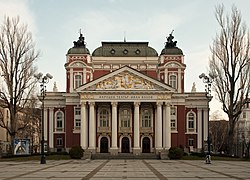Fellner & Helmer was an architecture studio founded in 1873 by Austrian architects Ferdinand Fellner and Hermann Helmer. They designed over 200 buildings (mainly opera houses and apartment buildings) across Europe in the late 19th and early 20th century, which helped bind the Austro-Hungarian Empire together and cement Vienna as its cultural center. [1] [2] While most of the work stood in the former Austro-Hungarian Empire, others can be found from Switzerland to present-day Ukraine. Frequent collaborators for integrated exterior and interior art work include Gustav Klimt, Hans Makart, Theodor Friedl, and other significant artists.












